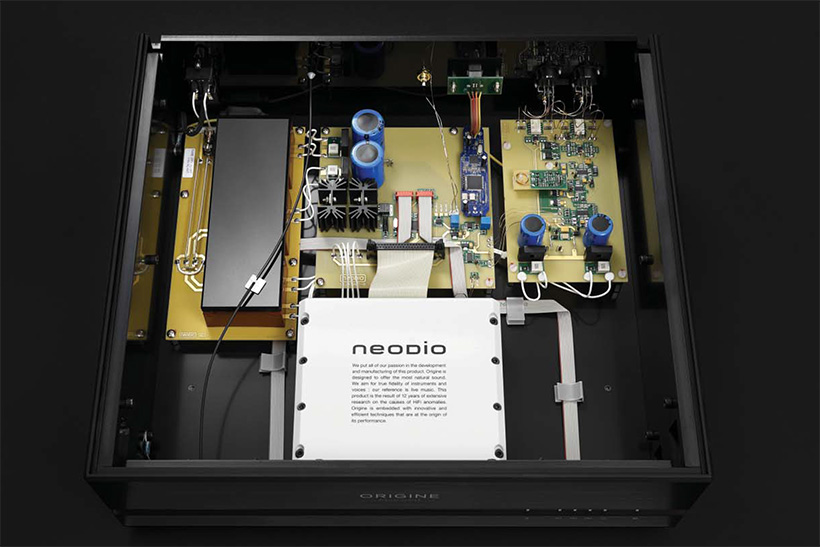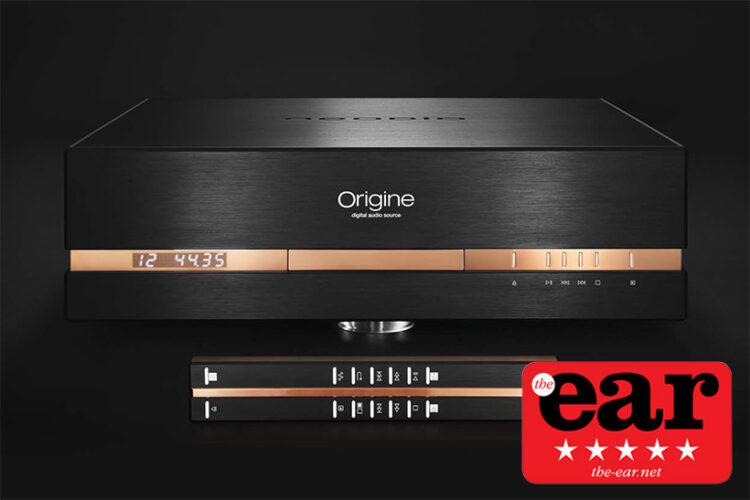There aren’t many really good CD players on the market today, they have always been pretty scarce in truth. There have been good ones and better ones but the reason for vinyl’s survival through the dark days that preceded its revival is that the competition was so weak. But oddly enough in what appear to be their dying days CD players continue to get better, and this substantial Neodio is amongst the very best digital sources I have encountered. I say substantial but what I mean is immovable, in no need of insurance against theft, but you might want to take it out for your back. You can tell from the height of the disc draw that it’s a big box but what is less obvious is how well it answers some of the format’s biggest challenges.
Kevin Scott at Definitive Audio is a big vinyl enthusiast but he uses CD to develop his Living Voice speakers because of its even tonal balance and consistency of performance. For a long time he used a Resolution Audio Opus 21 CD player as his reference but that went out of production several years ago to be replaced by the Cantata Music Centre, a multi function machine that doesn’t quite match its predecessor’s disc spinning skills. So he searched for some time to find something that did everything he was looking for, trying a lot of transport and DAC combinations as well as well regarded single box players before lighting upon the Origine.
Neodio is a relatively young French company that was started in 2002 by Stéphane Even, a man who appreciates that the purpose of good audio equipment is to “allow us to live a magical moment: our favourite artists are present with all the emotion of a live concert.” The methods he outlines for achieving that with electronics are not particularly unusual: discrete analogue clocks that are located closer to the conversion circuit; protecting circuitry from interference both within and outside of the component and listening to every part to find the best. He claims exclusivity for the clock technology but there is clearly something he’s not saying or something about his approach that gives the Origine qualities that are very rare in digital audio.

Neodio makes a small range of NR series electronics: three integrated amplifiers and two CD players that share the same natural aluminium fascias and yellow displays. The Origine is therefore a rather different beast, it’s a lot bigger and blacker and has a distinctive copper belt that almost hides the drawer front. It’s also a lot more expensive, three times the price of the NR 22HD which sits beneath it in the catalogue. I asked Stéphane why this is and got the following answer: “The reason for this is that the cost was not taken into consideration when we designed Origine. This was for me, a dream come true. I just wanted to create the most beautiful product with the best sound. The cost is due to the materials (Hi-Macs, copper, stainless steel, aluminium) and the very high quality French subcontractors we have. The one who manufactures the electronic boards and does the final assembly also does the electronic calculator of the Airbus A380 among other things. Last thing, if you compare the price of Origine with some competitors (dCS for instance) we are ‘small players’. Origine is very heavy (28kg) because we think that mechanical design is as important as electronic design. Hi-fi is a matter of vibration control at every level. Origine has a multilayer chassis with ‘hard materials and soft ones to make the damping.”
Hi-Macs is a type of composite stone rather like Corian so very hard, a discovery that made me wonder what other materials were being used in the chassis. These turn out to be: PMMA (Perspex/Plexiglass), aluminium, copper, stainless steel and a viscoelastic material. These are used to minimize resonance whilst maintaining high rigidity. Stéphane has grasped what surprisingly few others have which is that digital electronics are extremely sensitive to vibration, you only have to put a DAC on a decent isolation base to hear as much, and a DAC has no moving parts. What it does have is a quartz crystal based clock that oscillates at high frequency, adding external vibration to that oscillation naturally makes an impression on the final result.
Fluent fashion
In the system the Origine is an uncannily natural CD player, it’s not soft or harmonically enhanced in the way that players with tube outputs can be, it’s just sounds right. Sephardic Romances (Naxos) is a disc of early Jewish music from Spain made with voices and acoustic instruments. In the Origine’s hands it sounds bright, open and lively and voices are perfect, in fact on the second piece the hairs on the back of my neck were standing up, such was the realism. The instruments have texture and timbre and no shortage of vitality, the tympani sounds expansive and the whole piece is replete with musical detail presented in remarkably fluent fashion.
A more contemporary piece, ‘Trouble’ on Bugge Wesseltoft’s New Conception of Jazz (Jazzland) has lovely weight and the ebb and flow of the groove is rendered with precision but not a hint of grain. I particularly like the toffee cream tone of the bass sax, it just oozes its rich, ripe flavour into the room. Reverb and low level sounds are very well catered for, this much is obvious on everything you play and it contributes to the vitality of the overall result. The big musical picture is always dependent on the quality of its quietest elements, the reason why this player works so well is that it resolves the harmonics as well as it does the fundamentals. This makes string tone real and clarifies the distinction between closely harmonized instruments and voices.

The Origine is not light and fluffy though, I realize that some of the above might give the impression of say an SET sound, which is no bad thing of course but can’t usually provide definite bass lines with clear transients. This means that the bass and drums on ZZ Top’s remarkable ‘Enjoy And Get It On’ (Tejas, Warner Bros) has power and plenty of tension, it’s so damn syncopated that it’s hard to sit still and so tight that the smoke gets in your eyes. Who’d have thunk that blues-rock could be so emotionally powerful! A more sophisticated form of heavy syncopation is available on John Eliot Gardiner’s Beethoven The Symphonies (Orchestre Révolutionnaire et Romantique, Archiv), specifically the Allegreto from the 7th Symphony, which is beautifully paced on this player and delivers its full majesty and nuance. Barenboim’s later version of the same Symphony on Beethoven For All (Decca) has wider dynamic range and allows higher level replay thanks to the quality of recording, it is also more demonstrative if not perhaps as enchanting.
As the Origine is also a DAC I connected its USB input to a Macbook Air laptop with Vertere Dfi cable and played the Henry Threadgill Sextett’s ‘Bermuda Blues’ (You Know The Number, Novus). This was strong on space and smoother sounding than CD but can’t quite match the magic that this player can extract from silver discs. This is as much a reflection of the source as anything however, even running Audirvana Plus software a Macbook is not a hardcore computer audio source, you need a dedicated and powerful desktop to deliver a signal that could hope to compete with a CD player of this calibre. But access to the DAC is useful especially when you consider the growth of network streaming bridges with digital outputs. It is good enough however to make me realise how much potential certain music has, something that prompted a search for original discs.
Radiance
One such was Iiro Rantala’s Jazz at Berlin Philharmonic, Vol. 1 (ACT), this reveals the beautiful shine of the piano in the context of palpable crowd ambiance. Rantala manages to remain calm and in control despite the excitement all around, playing ‘Aria and Goldberg Variation’ with finesse and heart. This piece makes it clear that the Origine can reproduce the radiance of an acoustic piano rather better than most. The delicacy of his playing is sublime.
It really is hard to find CD players that have this combination of transparency, fine detail and tonal depth. Some of the best valve powered examples get close but it’s rare to find one that’s this fluent and revealing. You can’t do this with a network streamer either, it must be the amount of processing involved that holds them back, either that or the relative infancy of the technology. Higher bit/sample rates give greater refinement in presentation but not the musical flow on offer with this beast of a player. It’s not small and it’s certainly not cheap but CD players that can distract a dyed in the wool vinyl nut are scarce devices. Anyone with a decent collection of discs will find the Origine to be a serious contribution to road safety!


